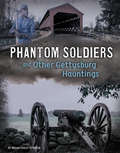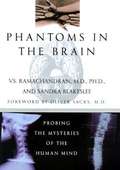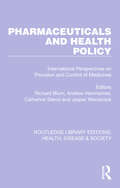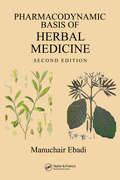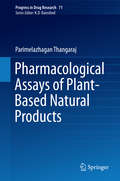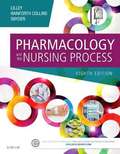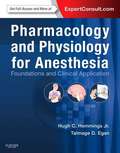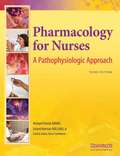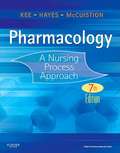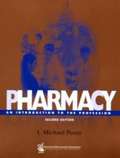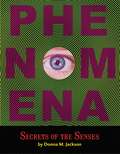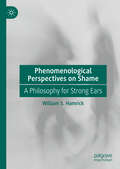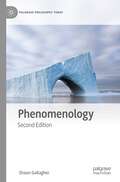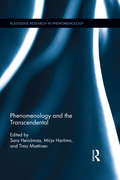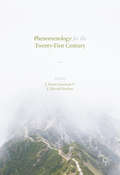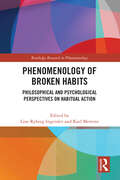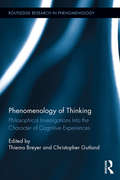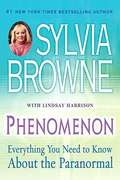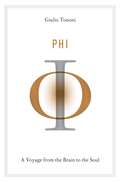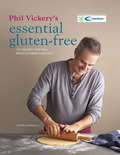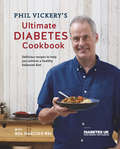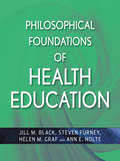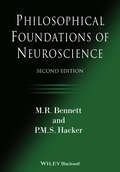- Table View
- List View
Phantom Soldiers and Other Gettysburg Hauntings (Haunted History)
by Megan Cooley PetersonPhantom cries from wounded soldiers echo through the air. Strange orbs of light appear in photographs. These stories and more are found at Gettysburg Battlefield, the site of a historical American Civil War battle. Readers will follow along in spooky delight as they discover the ghosts of Gettysburg, Pennsylvania.
Phantoms in the Brain: Probing the Mysteries of the Human Mind
by V. S. Ramachandran Sandra BlakesleeIn Phantoms in the Brain, Dr. Ramachandran recounts how his work with patients who have bizarre neurological disorders has shed new light on the deep architecture of the brain, and what these findings tell us about who we are, how we construct our body image, why we laugh or become depressed, why we may believe in God, how we make decisions, deceive ourselves and dream, perhaps even why we're so clever at philosophy, music and art.
Pharmaceuticals and Health Policy: International Perspectives on Provision and Control of Medicines (Routledge Library Editions: Health, Disease and Society #5)
by Richard BlumOriginally published in 1981, this comprehensive volume is intended for medical economists, clinical pharmacologists, physicians, pharmacists and consumers, as well as planner and administrators who must determine relevant policy and legislation in the area of the provision of medicines. The contributors believe that the system of drugs provision can benefit from being studied, by policy revisions and evaluation of the outcomes of policy operations.
Pharmacodynamic Basis of Herbal Medicine
by Manuchair EbadiContinuing in the tradition of the acclaimed first edition, Pharmacodynamic Basis of Herbal Medicine, Second Edition examines in extensive detail the physiologic effects of complimentary and alternative therapies, foods, supplements, vitamins, and traditional herbal remedies. The author considers the site, mode, and mechanism of action to ex
Pharmacological Assays of Plant-Based Natural Products
by Parimelazhagan ThangarajThis volume provides information on how to select and screen plants for their medicinal properties. It describes phytopharmacological techniques for extracting and qualitatively and quantitatively analyzing a plant's phytochemicals. After a detailed in vitro investigation including nutritional and anti-nutritional analyses, medicinal properties were tested with various in vivo models for anti-inflammatory, analgesic, anti-pyretic, anticancer and anti-diabetic properties, as well as wound healing, neurodegenerative diseases, etc. Compound identification and purification techniques include, among others, TLC and column chromatography, as well as molecular docking with specific proteins.
Pharmacology And The Nursing Process
by Linda Lane Lilley Shelly Rainforth Collins Julie S. SnyderLet this outstanding pharmacology text help you learn how to administer drugs safely and effectively! Now in its eighth edition, Pharmacology and the Nursing Process continues to deliver the perfect amount of pharmacology, prioritization, and nursing process information to today''s nursing students. Centering on its unique key drug approach, this text focuses only on the drug information you need to safely administer drugs. The text also continues to emphasize the nursing process and prioritization, covering the most essential assessments, nursing diagnoses, interventions, and evaluations you need to practice effectively. New to this edition is even more coverage of QSEN competencies, simpler language, and a wealth of reader-friendly features and innovative learning aids. Along with its integrated NCLEX preparation and insightful learning strategies, you won''t find a more complete pharmacology text on the market!
Pharmacology and Physiology for Anesthesia
by Hugh C. Hemmings Talmage D. EganBetter understand the complexities of pharmacology and physiology relevant to your practice with the brand-new medical reference book, Pharmacology and Physiology for Anesthesia. Drs. Hugh Hemmings and Talmage Egan provide the clinical insights you need to effectively administer anesthesia, ensuring patient safety and the most optimal outcomes. Access comprehensive, continually updated research on the physiology of organ systems and clinical topics in the pharmacology of anesthetic drugs. Quickly and easily reference the information you need through user-friendly tables, figures, and algorithms, all presented in lavish full color throughout. Understand the molecular mechanism of drug actions and identify key drug interactions that may complicate anesthesia with dedicated sections on these key areas. Search the text and download images online at Expert Consult. Build a thorough knowledge of pharmacology and physiology focused on clinical practice
Pharmacology for Nurses: A Pathophysiologic Approach (3rd Edition)
by Michael Patrick Adams Leland Norman Holland Jr. Carol Q. UrbanThe third edition of Pharmacology for Nurses: A Pathophysiologic Approach has been thoroughly updated to reflect current pharmacologic drugs and processes. This book is structured to present pharmacology and pathology together, so students can more easily grasp the interrelationship between these subjects and patient care.
Pharmacology: A Nursing Process Approach (7th Edition)
by Joyce Lefever Kee Evelyn R. Hayes Linda E. MccuistionFeaturing concise, straightforward coverage, Pharmacology: A Nursing Process Approach, 7th Edition puts nursing pharmacology concepts and essential drug calculation skills into a practical nursing context to prepare you for real-world drug administration responsibilities. This edition has been revised and updated with the most current nursing pharmacology information available. Innovative features such as Prototype Drug Charts, Nursing Process Summaries, an extensive math/dosage calculation section, and NCLEX Examination-style study questions make nursing pharmacology more understandable than ever. Unique! Prototype Drug Charts provide easy access to key information on dosages, contraindications, drug-lab-food interactions, pharmacokinetics, and more for more than 100 drugs. Unique! An extensive, color-coded dosage calculation section covers six methods of dosage calculation - basic formula, ratio and proportion, fractional equation, dimensional analysis, and dosing by body weight and body surface area - eliminating the need for a separate dosage calculation book. Nursing Process Summaries present client care and drug therapy within the framework of each step of the nursing process, including information on client teaching and cultural and herbal considerations. Preventing Medication Errors boxes reinforce concepts introduced in the medication safety chapter and highlight common errors that occur in clinical practice to help you ensure safe drug administration. Herbal Alerts provide a quick reference to side effects, drug interactions, and additional information for popular herbs you may encounter in practice. A fully updated bioterrorism appendix helps you recognize the clinical manifestations of bioterrorism weapons and respond with appropriate nursing care. Unique! Illustrated overviews of normal anatomy and physiology in all drug therapy chapters help you understand how drugs work in various body systems. Critical Thinking Case Studies at the end of each chapter challenge you to apply your knowledge and analytical skills to realistic client scenarios. NCLEX Study Questions for each chapter help prepare you for the growing pharmacology coverage on the NCLEX Examination. Answers are listed upside-down at the bottom of the page for quick feedback. New medication safety chapter discusses medication errors, specific nursing measures to prevent medication errors, possible consequences of medication errors to nurses, responses to errors, reporting and learning from mistakes, and related ethical issues. Enhanced NCLEX Examination-style study questions are now more application-based and include at least one alternate-item format question per chapter. Updated chapters on cultural considerations and women's health bring you the latest information on these important considerations in drug therapy. More reader-friendly and understandable than ever, this edition features helpful new photos throughout.
Pharmacy: An Introduction to the Profession
by L. Michael PoseyAs editorial director of the APA, Posey updates his 2003 textbook introducing not the technical aspects of pharmacy, but the nature of the profession itself. It supplies core knowledge needed to put information from other courses into perspective, and is best supplements with lectures from pharmacy faculty or administrators. Revisions are based on student and instructor feedback, as well as changes in the profession and recent publications. American Pharmacists Association books are distributed by McGraw-Hill. Annotation ©2009 Book News, Inc., Portland, OR (booknews.com)
Phenomena: Secrets of the Senses
by Donna M. JacksonCan paranormal experiences help solve crimes?What makes us have chills when we go to a haunted house?Can dogs detect cancer? Your senses send your brain messages. But what do those messages say? Find out how to interpret your senses and explore ways that technology is changing the way we experience the world around us.
Phenomenological Perspectives on Shame: A Philosophy for Strong Ears
by William S. HamrickThis book utilizes Maurice Merleau-Ponty’s fascinating philosophy of embodiment to cast further light on the incredibly rich and complex phenomenon of shame. The philosopher himself made only scattered references to shame, but both his early phenomenology and his later phenomenological ontology do provide unique illumination of the phenomenon. The book demonstrates how Merleau-Ponty’s work is relevant to those of certain other thinkers in the analytic tradition.
Phenomenology (Palgrave Philosophy Today)
by Shaun GallagherWith a focus on phenomenological methods, this new edition of Shaun Gallagher’s highly regarded textbook provides a comprehensive introduction to phenomenology considered as a philosophical and interdisciplinary practice. Phenomenology 2e encompasses both the classic 20th century explications of phenomenology as well as recent developments in the practical and scientific uses of phenomenology.Key features: Explores debates about naturalizing phenomenology and reviews recent extensions of phenomenological methodology. Relates the phenomenological analysis of intentionality to discussions of enactive perception. Includes a discussion of the phenomenology of performance and a new chapter on critical phenomenology. Examines specialized topics in phenomenology, including Husserl’s concept of hyletic data, embodiment, time-consciousness, action, intersubjectivity and self-consciousness. Each chapter concludes with suggestions for further reading. This book is essential reading for all undergraduate and graduate philosophy students taking courses in phenomenology. It is also ideal for use on cognitive science modules that incorporate a phenomenological perspective.
Phenomenology and the Transcendental (Routledge Research in Phenomenology)
by Mirja Hartimo Sara Heinämaa Timo MiettinenThe aim of this volume is to offer an updated account of the transcendental character of phenomenology. The main question concerns the sense and relevance of transcendental philosophy today: What can such philosophy contribute to contemporary inquiries and debates after the many reasoned attacks against its idealistic, aprioristic, absolutist and universalistic tendencies—voiced most vigorously by late 20th century postmodern thinkers—as well as attacks against its apparently circular arguments and suspicious metaphysics launched by many analytic philosophers? Contributors also aim to clarify the relations of transcendental phenomenology to other post-Kantian philosophies, most importantly to pragmatism and Wittgenstein’s philosophical investigations. Finally, the volume offers a set of reflections on the meaning of post-transcendental phenomenology.
Phenomenology for the Twenty-First Century
by J. Aaron Simmons and J. Edward HackettThis volume illustrates the relevance of phenomenology to a range of contemporary concerns. Displaying both the epistemological rigor of classical phenomenology and the empirical analysis of more recent versions, its chapters discuss a wide range of issues from justice and value to embodiment and affectivity. The authors draw on analytic, continental, and pragmatic resources to demonstrate how phenomenology is an important resource for questions of personal existence and social life. The book concludes by considering how the future of phenomenology relates to contemporary philosophy and related academic fields.
Phenomenology of Broken Habits: Philosophical and Psychological Perspectives on Habitual Action (Routledge Research in Phenomenology)
by Karl Mertens Line Ryberg IngerslevThis volume explores the phenomenology of broken habits and their affective, social, and involuntary dimensions. It shows how disruptive experiences impact self-understanding and social embeddedness.The chapters in this volume investigate the epistemic and existential relevance of breakdown of habits and the corresponding kinds of self-understanding available to the agent. The first part focuses on the double-sidedness of habitual life. On the one hand, habits allow us to arrange and navigate in a familiar home world; on the other hand, habits can take hold of us in such a way that we lose our sense of autonomy. The contributors argue that habitual agency is structurally carried by a dynamic that entails both freedom and necessity. As habits enable us to inhabit and thus acquire a world, they also affectively provide a texture and a background for our feeling at home in the world. The chapters in Part 2 focus on the breakdowns of our habitual social and technological life forms and the phenomenology of their affective texture. History and habitual learning are sedimented in our body memory and in our language, and these sedimented layers are partly out of our direct control. Part 3 focuses on the structural openness of habits in relating to one’s past and one’s traumatic experiences. Part 4 reflects on the ways in which we might become aware of and thus transform or appropriate our culturally given habits.Phenomenology of Broken Habits will appeal to researchers and advanced students working in phenomenology, philosophy of mind, and philosophy of psychology.
Phenomenology of Thinking: Philosophical Investigations into the Character of Cognitive Experiences (Routledge Research in Phenomenology #4)
by Thiemo Breyer Christopher GutlandThis book draws connections between recent advances in analytic philosophy of mind and insights from the rich phenomenological tradition concerning the nature of thinking. By combining both analytic and continental approaches, the volume arrives at a more comprehensive understanding of the mental process of "thinking" and the experience and manipulation of objects of thought. Contributors scrutinize aspects of thinking that have a common grounding in both the phenomenological and analytic tradition: perception, language, logic, embodiment and situatedness due to individual history or current experience. This collection serves to broaden and enrich the current debate over "cognitive phenomenology," and lays the foundations for further dialogue between analytic and continental approaches to the phenomenal character of thinking.
Phenomenon: Everything You Need to Know About the Paranormal
by Sylvia Browne Lindsay HarrisonIn this compelling new book, bestselling author Sylvia Browne offers her most comprehensive guide to the afterlife. Phenomenon is a fascinating compendium of all things on the Other Side that influence our life here on Earth. Sylvia Browne provides evocative stories and powerful explanations to help make life on the Other Side real for all of us. In Phenomenon, she provides reassuring answers to questions such as: Atlantis - Where did it go and when will it return? Clairvoyance - How do you know if you have the gift? Deja vu - Are past lives the answer to this strange phenomenon? Ghosts - What are they? Miracles - Can they happen every day? Reincarnation - Have we lived before? Sorcery - Is there something we should fear? Zombies - Are they only in horror movies? An easy-to-use reference full of hope and guidance, Phenomenon is sure to have wide appeal among Browne's loyal fans and anyone in search of signs of the paranormal.
Phi: A Voyage from the Brain to the Soul
by Giulio TononiThis title is printed in full color throughout.From one of the most original and influential neuroscientists at work today, here is an exploration of consciousness unlike any other--as told by Galileo, who opened the way for the objectivity of science and is now intent on making subjective experience a part of science as well. Galileo's journey has three parts, each with a different guide. In the first, accompanied by a scientist who resembles Francis Crick, he learns why certain parts of the brain are important and not others, and why consciousness fades with sleep. In the second part, when his companion seems to be named Alturi (Galileo is hard of hearing; his companion's name is actually Alan Turing), he sees how the facts assembled in the first part can be unified and understood through a scientific theory--a theory that links consciousness to the notion of integrated information (also known as phi). In the third part, accompanied by a bearded man who can only be Charles Darwin, he meditates on how consciousness is an evolving, developing, ever-deepening awareness of ourselves in history and culture--that it is everything we have and everything we are. Not since Gödel, Escher, Bach has there been a book that interweaves science, art, and the imagination with such originality. This beautiful and arresting narrative will transform the way we think of ourselves and the world.
Phil Vickery's Essential Gluten Free
by Phil VickerySince Phil Vickery published his first gluten-free book in 2009, the number of people opting to go gluten-free has risen dramatically - 13% of the UK population now say they avoid gluten; in Finland the number of coeliacs has more than doubled in 20 years and in Italy it has doubled since 2007. A notoriously restrictive diet, it can seem the end of exciting food, but Phil uses his Michelin-starred cooking talents and simple, honest ingredients to create dishes that everyone in the family can eat - including the pizza, bread, pasta, cakes and biscuits that you thought you would never enjoy again. The 175 delicious recipes take their inspiration from cuisines around the world and range from Lasagnette with Asparagus and Tomatoes to Easy Pad Thai Noodles and American-style Pancakes with Pears and Almonds.
Phil Vickery's Essential Gluten Free
by Phil VickerySince Phil Vickery published his first gluten-free book in 2009, the number of people opting to go gluten-free has risen dramatically - 13% of the UK population now say they avoid gluten; in Finland the number of coeliacs has more than doubled in 20 years and in Italy it has doubled since 2007. A notoriously restrictive diet, it can seem the end of exciting food, but Phil uses his Michelin-starred cooking talents and simple, honest ingredients to create dishes that everyone in the family can eat - including the pizza, bread, pasta, cakes and biscuits that you thought you would never enjoy again. The 175 delicious recipes take their inspiration from cuisines around the world and range from Lasagnette with Asparagus and Tomatoes to Easy Pad Thai Noodles and American-style Pancakes with Pears and Almonds.
Phil Vickery's Ultimate Diabetes Cookbook: Delicipis Recipes To Help You Achieve A Healthy Balanced Dite
by Phil VickeryWinner - Gourmand World Cookbook Awards: Best World Gourmand Cookbook Health and Nutrition 2017 Being diagnosed with Type 2 Diabetes needn't mean an end to enjoying food. In his bestselling gluten-free cookbooks, Phil Vickery showed it's possible to overcome dietary restrictions and still eat well. Now he's turned his attention to creating recipes that will help diabetics take control of their diet and lower their blood sugar levels, with the endorsement of Diabetes UK. Organised into Breakfasts, Light Bites, Soup & Lunch, Main Meals, Sweet Things & Drinks and Sides & Dressings, the recipes are accompanied by nutritional analysis and at-a-glance `traffic light' labelling. They include delicious dishes such as Squash, Feta & Hazelnut Salad and Roast Butterfly Chicken with Pomegranate, Lemon, Garlic & Mint, and cakes and desserts such as Banana Pinenut Cake and Easy Chocolate Mousse. With advice on achieving (and maintaining) a healthy weight, practical tips on eating less refined carbohydrates, smaller portions, and nutrient dense ingredients, Phil makes eating sensibly easier and more appealing than ever.
Phil Vickery's Ultimate Diabetes Cookbook: Supported by Diabetes UK
by Phil VickeryWinner - Gourmand World Cookbook Awards: Best World Gourmand Cookbook Health and Nutrition 2017 Being diagnosed with Type 2 Diabetes needn't mean an end to enjoying food. In his bestselling gluten-free cookbooks, Phil Vickery showed it's possible to overcome dietary restrictions and still eat well. Now he's turned his attention to creating recipes that will help diabetics take control of their diet and lower their blood sugar levels, with the endorsement of Diabetes UK. Organised into Breakfasts, Light Bites, Soup & Lunch, Main Meals, Sweet Things & Drinks and Sides & Dressings, the recipes are accompanied by nutritional analysis and at-a-glance `traffic light' labelling. They include delicious dishes such as Squash, Feta & Hazelnut Salad and Roast Butterfly Chicken with Pomegranate, Lemon, Garlic & Mint, and cakes and desserts such as Banana Pinenut Cake and Easy Chocolate Mousse. With advice on achieving (and maintaining) a healthy weight, practical tips on eating less refined carbohydrates, smaller portions, and nutrient dense ingredients, Phil makes eating sensibly easier and more appealing than ever.
Philosophical Foundations of Education (9th Edition)
by Howard A. OzmanNow in its ninth edition, Philosophical Foundations of Education provides readers with comprehensive knowledge about the various schools of thought that have comprised the philosophy of education throughout history. Highly readable, this chronological text gives insight into the individuals who helped develop various philosophies of education and provides historical information about how they lived and how they learned. In addition, each chapter covers each philosophy’s aims, methods, curriculums, teaching roles, advantages, and disadvantages. Covering not only how each philosophy evolved over time but also how these philosophies influenced subsequent educational practice, this popular textbook also challenges readers to apply what they have learned in their own profession and develop their own philosophies about education, instruction, and schooling.
Philosophical Foundations of Neuroscience
by P. M. Hacker M. R. BennettThe second edition of the seminal work in the field—revised, updated, and extended In Philosophical Foundations of Neuroscience, M.R. Bennett and P.M.S. Hacker outline and address the conceptual confusions encountered in various neuroscientific and psychological theories. The result of a collaboration between an esteemed philosopher and a distinguished neuroscientist, this remarkable volume presents an interdisciplinary critique of many of the neuroscientific and psychological foundations of modern cognitive neuroscience. The authors point out conceptual entanglements in a broad range of major neuroscientific and psychological theories—including those of such neuroscientists as Blakemore, Crick, Damasio, Dehaene, Edelman, Gazzaniga, Kandel, Kosslyn, LeDoux, Libet, Penrose, Posner, Raichle and Tononi, as well as psychologists such as Baar, Frith, Glynn, Gregory, William James, Weiskrantz, and biologists such as Dawkins, Humphreys, and Young. Confusions arising from the work of philosophers such as Dennett, Chalmers, Churchland, Nagel and Searle are subjected to detailed criticism. These criticisms are complemented by constructive analyses of the major cognitive, cogitative, emotional and volitional attributes that lie at the heart of cognitive neuroscientific research. Now in its second edition, this groundbreaking work has been exhaustively revised and updated to address current issues and critiques. New discussions offer insight into functional magnetic resonance imaging (fMRI), the notions of information and representation, conflict monitoring and the executive, minimal states of consciousness, integrated information theory and global workspace theory. The authors also reply to criticisms of the fundamental arguments posed in the first edition, defending their conclusions regarding mereological fallacy, the necessity of distinguishing between empirical and conceptual questions, the mind-body problem, and more. Essential as both a comprehensive reference work and as an up-to-date critical review of cognitive neuroscience, this landmark volume: Provides a scientifically and philosophically informed survey of the conceptual problems in a wide variety of neuroscientific theories Offers a clear and accessible presentation of the subject, minimizing the use of complex philosophical and scientific jargon Discusses how the ways the brain relates to the mind affect the intelligibility of neuroscientific research Includes fresh insights on mind-body and mind-brain relations, and on the relation between the notion of person and human being Features more than 100 new pages and a wealth of additional diagrams, charts, and tables Continuing to challenge and educate readers like no other book on the subject, the second edition of Philosophical Foundations of Neuroscience is required reading not only for neuroscientists, psychologists, and philosophers, but also for academics, researchers, and students involved in the study of the mind and consciousness.
